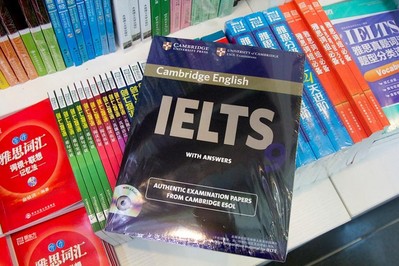 返回
教育头条
返回
教育头条

这些技巧让你雅思考试不再犯小错误 雅思培训
今天小编告诉你技巧让你雅思不再犯小错误。
there be 句型与 have/has 混杂使用
这一问题的出现,要归罪于现在完成时的 there be 句型,如 There has been a big change in my hometown.
有许多考生在记住这个句子之后在想表示 " 有 " 这个谓语动词的时候都,往往会把 there be 与 have/has 同时出现在一句话中,而句子的含义并非想表达现在完成时。
如:There have many wild animals in my country. 而正确的说法为 There are many wild animals in my country. 或 My country has many wild animals.形容词 ing 与 ed 的区别
你可能可以熟练的背出 "ing 是形容一件事或一种东西,ed 是形容人 " 这一口诀,但是你敢肯定自己在作答中不会犯这种错误码 ?
看以下几组形容词:interesting 与 interested; exciting 与 excited; surprising 与 surprised。
什么叫形容人 ? 基本上来讲,可能出现的情况无非以下两种:
a. somebody be 动词 以 ed 结尾的形容词 介词 something 如:I'm surprised about this piece of news.
b. something make ( s ) somebody 以 ed 结尾的形容词 如:This piece of news makes me surprised.
什么叫形容一件事或一种东西 ? 也就是:
a. something be 动词 以 ing 结尾的形容词 如:This piece of news is surprising.
b. 以 ing 结尾的形容词 名词 如 This is a surprising piece of news.
时态时态错误可以算语法错误中低级而又不易发现的两种了。它的低级是因为时态是所有考生在笔头上都已掌握的很好 ; 但一转到口头上,就很难保持了。请看以下的例子:
Part I 问题:Why did you choose to study that subject? 针对这个问题,可能你的口语老师会教你用 "the reason why I … is that … " 这个句型来回答。

但所有考生在第1次作答时,基本上都会忽略所提出问题的时态,而在作答时用一般现在时来回答:The reason why I choose to study this subject is that I am interested in learning it at that time。
很显然,正确的回答应该把句中的 choose 变为 chose,is 变为 was,am 也要相应的变成 was: 如:The reason why I chose to study this subject was that I was interested in learning it at that time.
情态动词后不加动词原形
有的考生会因为过度时态问题,如一味的想着整个作答都要基于某种时态而忽略情态动词后要加动词原形这一原则。如 I thought the reason why I chose to study that subject was I could got a better job after learning that。
而正确的说法则是 I thought the reason why I chose to study that subject was I could get a better job after learning that.
动词短语忽略成分
有些动词短语的搭配是固定的,只有把短语完整的说全的情况下才可以接之后的名词,但许多考生很容易忽视这一点。如:listen to, go to, look forward to, pay attention to 等等。所以我们要在练习中尽可能的回忆当时学校课堂上所交的那些口诀,来确保每一个说出的动词短语不会遗忘任何成分。
there be 句型与 have/has 混杂使用
这一问题的出现,要归罪于现在完成时的 there be 句型,如 There has been a big change in my hometown.
有许多考生在记住这个句子之后在想表示 " 有 " 这个谓语动词的时候都,往往会把 there be 与 have/has 同时出现在一句话中,而句子的含义并非想表达现在完成时。
如:There have many wild animals in my country. 而正确的说法为 There are many wild animals in my country. 或 My country has many wild animals.形容词 ing 与 ed 的区别
你可能可以熟练的背出 "ing 是形容一件事或一种东西,ed 是形容人 " 这一口诀,但是你敢肯定自己在作答中不会犯这种错误码 ?
看以下几组形容词:interesting 与 interested; exciting 与 excited; surprising 与 surprised。
什么叫形容人 ? 基本上来讲,可能出现的情况无非以下两种:
a. somebody be 动词 以 ed 结尾的形容词 介词 something 如:I'm surprised about this piece of news.
b. something make ( s ) somebody 以 ed 结尾的形容词 如:This piece of news makes me surprised.
什么叫形容一件事或一种东西 ? 也就是:
a. something be 动词 以 ing 结尾的形容词 如:This piece of news is surprising.
b. 以 ing 结尾的形容词 名词 如 This is a surprising piece of news.
时态时态错误可以算语法错误中低级而又不易发现的两种了。它的低级是因为时态是所有考生在笔头上都已掌握的很好 ; 但一转到口头上,就很难保持了。请看以下的例子:
Part I 问题:Why did you choose to study that subject? 针对这个问题,可能你的口语老师会教你用 "the reason why I … is that … " 这个句型来回答。

但所有考生在第1次作答时,基本上都会忽略所提出问题的时态,而在作答时用一般现在时来回答:The reason why I choose to study this subject is that I am interested in learning it at that time。
很显然,正确的回答应该把句中的 choose 变为 chose,is 变为 was,am 也要相应的变成 was: 如:The reason why I chose to study this subject was that I was interested in learning it at that time.
情态动词后不加动词原形
有的考生会因为过度时态问题,如一味的想着整个作答都要基于某种时态而忽略情态动词后要加动词原形这一原则。如 I thought the reason why I chose to study that subject was I could got a better job after learning that。
而正确的说法则是 I thought the reason why I chose to study that subject was I could get a better job after learning that.
动词短语忽略成分
有些动词短语的搭配是固定的,只有把短语完整的说全的情况下才可以接之后的名词,但许多考生很容易忽视这一点。如:listen to, go to, look forward to, pay attention to 等等。所以我们要在练习中尽可能的回忆当时学校课堂上所交的那些口诀,来确保每一个说出的动词短语不会遗忘任何成分。
以上就是教育宝头条为大家带来的这些技巧让你雅思考试不再犯小错误 雅思培训,感谢您的观看雅思相关资讯。本站提供雅思培训、资讯、资料,详细联系我微信:18560125702喜欢记得点赞哦,教育宝头条,每天都为你带来新鲜的学习资讯,别忘了关注哦。返回教育宝头条
【免责声明】本文仅代表作者本人观点,与教育宝无关。教育宝对文中陈述、观点判断保持中立,不对所包含内容的准确性、可靠性或完整性提供任何保证。请读者仅作参考,特此声明!





